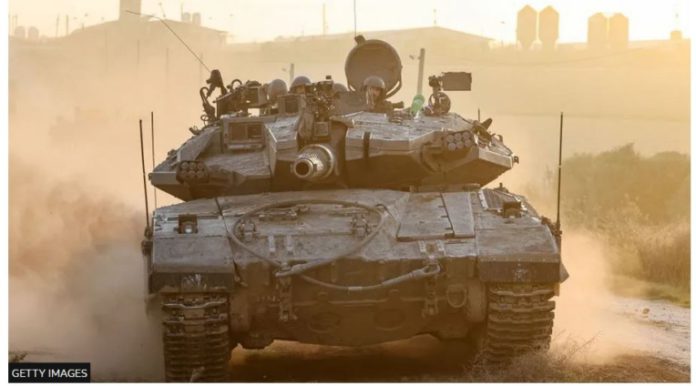Israeli ground forces are pushing into southern Gaza, after three days of heavy bombardment.
Initial reports from Israeli army radio effectively confirmed Israel has launched a ground operation to the north of Khan Younis.
The BBC has also verified images of an Israeli tank operating near the city.
The head of the Israel Defense Forces (IDF) later told troops the IDF was also fighting “strongly and thoroughly” in south Gaza.
Lt General Herzi Halevi was speaking to reservists from the Gaza division about military objectives and the IDF’s killing of Hamas commanders.
He told the soldiers: “We fought strongly and thoroughly in the northern Gaza Strip, and we are also doing it now in the southern Gaza Strip”.
An IDF spokesman later confirmed Israel “continues to expand the ground incursion” across all of Gaza, including troops “conducting face to face battles with terrorists”.
Since a week-long ceasefire ended on Friday, Israel has resumed a large-scale bombing campaign on Gaza, which residents of Khan Younis have described as the heaviest wave of attacks so far.
The seven-day truce saw Hamas release 110 hostages being held in Gaza in return for 240 Palestinians being released from Israeli prisons.
On Sunday morning, the Israeli army issued evacuation orders for several districts of Khan Younis, urging people to leave immediately.
Israeli authorities believe members of the Hamas leadership are hiding in the city, where hundreds of thousands of people have been sheltering after fleeing fighting in the north in the early stages of the war.
A UN official has described a “degree of panic” he has not seen before in a Gaza hospital, after the Israeli military shifted the focus of its offensive to the south.
James Elder, from the children’s agency Unicef, described Nasser Medical Hospital in Khan Younis as a “warzone”.
An adviser to Israel’s prime minister said Israel is making “maximum effort” to avoid killing civilians.
Mr Elder told the BBC he could hear constant large explosions close to the Nasser hospital and children were arriving with head injuries, terrible burns, and shrapnel from recent blasts.
“It’s a hospital I’ve gone to regularly and the children know me now, the families know me now. Those same people are grabbing my hand, or grabbing my shirt saying ‘please take us somewhere safe. Where is safe?'”
“They are unfortunately asking a question to which the only answer is there is nowhere safe. And that includes for them, as they know, that hospital,” he said.
The Hamas-run health ministry in Gaza says more than 500 people have been killed since the bombing resumed.
More than 15,500 people have been killed in the strip since the war began, the ministry also said.

Mohammed Ghalayini, a British-Palestinian who has stayed in Gaza, said the situation in the city was “beyond catastrophic”.
“People have been, for 50 days or more, withstanding brutal Israeli onslaught and are very low on all resources – food, water, power and the sanitation and the waste services,” he told the BBC by phone, before the connection cut off.
The air pollution expert, who normally lives in Manchester, arrived in Gaza for a three-month visit to see his mother shortly before the 7 October attacks.
Israel began its retaliatory bombing of Gaza following Hamas’s attacks on southern Israel on 7 October, which saw around 1,200 people killed and 240 taken hostage.
Rockets have also been regularly fired at Israel from Gaza since fighting resumed on Friday. A 22-year-old man in the city of Holon, near Tel Aviv, was treated for minor shrapnel injuries on Saturday.
Hundreds of thousands of people have already fled the fighting to take shelter in Khan Younis, after Israel told them to leave the north of the strip.
The latest UN update says around 1.8 million people are internally displaced in Gaza.
Speaking to the BBC, the UN’s human rights chief, Filippo Grandi, said Palestinians in the Gaza Strip are being “pushed more and more towards a narrow corner of what is already a very narrow territory”.
The IDF has begun posting maps of areas set to be attacked online. It says these maps, along with other measures like phone calls and leaflets being dropped on Gaza by plane, will warn people to evacuate.
Speaking to the BBC’s Sunday with Laura Kuenssberg programme, Prime Minister Benjamin Netanyahu’s senior adviser Mark Regev said civilians are not targets and protecting them is made more difficult by Hamas “embedding its military terror machine” in civilian neighbourhoods.
He says the IDF are trying to be “as surgical as we can in a very difficult combat situation”, and has given advance warning of attacks.
Separately, the IDF say they have destroyed 500 “terror tunnel” shafts used by Hamas in Gaza, out of the 800 they say have been found so far.
It also said around 10,000 air strikes on “terror targets” have been carried out by the air force “under the guidance of IDF soldiers on the ground” since the war began.
ALSO READ:

